 “Is it World Music?” “Is it Spanish Music?” “Is this Jazz?” “Is this in the Acoustic Genre?” Fortunately for guitar virtuoso and now-Pro D.I.Y’er Eric Hansen, the simple answer to these questions he faces regularly about his music is, “YES.” Eric is another longtime SONAR user who depends on SONAR daily for his livelihood. He is based out of Southern Florida which might just be where his Spanish and Latin influences come from, where at a young age he had a unique fondness for Flamenco infused Pop music.
“Is it World Music?” “Is it Spanish Music?” “Is this Jazz?” “Is this in the Acoustic Genre?” Fortunately for guitar virtuoso and now-Pro D.I.Y’er Eric Hansen, the simple answer to these questions he faces regularly about his music is, “YES.” Eric is another longtime SONAR user who depends on SONAR daily for his livelihood. He is based out of Southern Florida which might just be where his Spanish and Latin influences come from, where at a young age he had a unique fondness for Flamenco infused Pop music.
Eric began studying the guitar at age 14 and was performing professionally with local rock groups by the age 16. He then attended Florida Atlantic University where he studied Classical and Jazz guitar and was the first actual guitarist to complete the Honors Performance Program at F.A.U. He went on to graduate with academic honors while simultaneously studying Flamenco and Latin American music with musicians from Spain and Peru.
 In his professional career, Eric is no stranger to the Billboard Charts with 6 records under his belt all crafted in different versions of SONAR spanning over 15 years. Eric is in the final stages of another record, but this one is being tracked, mixed and recorded all in SONAR Platinum. After Eric getting Cakewalk an exclusive preview to 3 of the new songs on the record, we were interested in finding out more about how all these great tracks are coming together in Platinum [DEMO PREVIEW]:
In his professional career, Eric is no stranger to the Billboard Charts with 6 records under his belt all crafted in different versions of SONAR spanning over 15 years. Eric is in the final stages of another record, but this one is being tracked, mixed and recorded all in SONAR Platinum. After Eric getting Cakewalk an exclusive preview to 3 of the new songs on the record, we were interested in finding out more about how all these great tracks are coming together in Platinum [DEMO PREVIEW]:
CAKEWALK: What is the typical chain recording the guitars going into SONAR?
 E. HANSEN: For recording acoustic guitars, I’m getting the best results with a matched pair of Earthworks SR30s in an X-Y configuration. I have two mic preamps, the Pendulum SPS1 and a Groove Tubes SuPRE. These 2 channel pres sent into an Antelope Pure 2 AD/DA converter, out to the SPDIF IN of my RME HDSP9652 audio card and captured into SONAR. I’m recording with primarily three guitars. A Robert Ruck Classical guitar, a Lester Devoe Flamenco guitar and an old Guild Steel String. I tend to use the Pendulum SPS1 more because of the excellent EQ on each channel. I’ve figured out the troublesome frequencies of each guitar and use the QuadCurve EQ initially to pull down the areas that boom too much or sound harsh. For example the Ruck has a bit of an explosive sound at 220Hz which I pull down 3-4dB with a medium Q. The Devoe usually needs a gentle pull somewhere around 700Hz to reduce harshness. Also, I like to add little bit of highs around 10k with a wide Q for some sparkle.
E. HANSEN: For recording acoustic guitars, I’m getting the best results with a matched pair of Earthworks SR30s in an X-Y configuration. I have two mic preamps, the Pendulum SPS1 and a Groove Tubes SuPRE. These 2 channel pres sent into an Antelope Pure 2 AD/DA converter, out to the SPDIF IN of my RME HDSP9652 audio card and captured into SONAR. I’m recording with primarily three guitars. A Robert Ruck Classical guitar, a Lester Devoe Flamenco guitar and an old Guild Steel String. I tend to use the Pendulum SPS1 more because of the excellent EQ on each channel. I’ve figured out the troublesome frequencies of each guitar and use the QuadCurve EQ initially to pull down the areas that boom too much or sound harsh. For example the Ruck has a bit of an explosive sound at 220Hz which I pull down 3-4dB with a medium Q. The Devoe usually needs a gentle pull somewhere around 700Hz to reduce harshness. Also, I like to add little bit of highs around 10k with a wide Q for some sparkle.
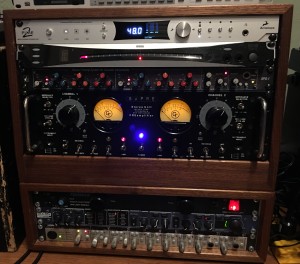 Since my recording space is also my mixing space, ambience is more or less a non-factor. The room is dead so I record with very close microphone positions—typically about 12-14 inches away from the guitar between the sound hole and the neck joint. Since I’m doing everything myself, I have to engineer, record and edit my parts while trying to be efficient with my time and not interrupt the creative flow. This means I have to sit close to the desk with guitar in hand, mics in front of me and my computer keyboard/mouse within reach to my left. It’s not ideal but that is life on a low budget. The tough part is getting a good sound at the beginning of a session. I find it difficult to judge the sound of my guitar in headphones. I have to record a segment, then listen back on my monitors and make adjustments to the mic position or preamp and repeat. Once I get into the session I prefer to record with one ear exposed to the acoustic sound of the guitar and the other covered with the headphones.
Since my recording space is also my mixing space, ambience is more or less a non-factor. The room is dead so I record with very close microphone positions—typically about 12-14 inches away from the guitar between the sound hole and the neck joint. Since I’m doing everything myself, I have to engineer, record and edit my parts while trying to be efficient with my time and not interrupt the creative flow. This means I have to sit close to the desk with guitar in hand, mics in front of me and my computer keyboard/mouse within reach to my left. It’s not ideal but that is life on a low budget. The tough part is getting a good sound at the beginning of a session. I find it difficult to judge the sound of my guitar in headphones. I have to record a segment, then listen back on my monitors and make adjustments to the mic position or preamp and repeat. Once I get into the session I prefer to record with one ear exposed to the acoustic sound of the guitar and the other covered with the headphones.
CAKEWALK: With this style of music, what is your process for recording all these guitar parts?
E. HANSEN: When recording I don’t layer comps or use loop record. I like to redo the take until I get it right. Some old habits are hard to get away from so CTRL-Z is worn out on my keyboard, LOL! I edit the material on the fly inside one take lane in the track view. I like to work in the quickest way I can to get the overall job done. I don’t want go back and sort through a bunch of takes and piece it together later on. I prefer to form a cohesive take in one session and be done.
CAKEWALK: What are some specific features in Platinum that have helped you deliver this new record?
 E. HANSEN: The best thing about SONAR is how logical the design of the program is. It’s the easiest DAW to work in. I’ve tried a few demos of competing software and it just makes me appreciate SONAR even more. When I was first starting to use it (Pro Audio 9), everything I needed to use was in a place I expected to find it. The learning curve is not steep at all. That has continued to improve over the past 10 years. The addition of the Pro Channel, PRV improvements and windows management enhancements have all been wonderful. When the Skylight interface was introduced in X1 my workflow started to speed up considerably. I swore by a dual display setup for years and would work with the track view in one display and the console view in the other. When the Inspector, Browser and Multidock were introduced I started to see the potential of not needing a dual display setup anymore. Eventually I switched to a 50” 4K TV as my display and it has been awesome. I get a ton of channel strips on the screen which makes mixing and editing a lot easier. It’s also easier to see when I’m sitting little farther from my desk and tracking parts.
E. HANSEN: The best thing about SONAR is how logical the design of the program is. It’s the easiest DAW to work in. I’ve tried a few demos of competing software and it just makes me appreciate SONAR even more. When I was first starting to use it (Pro Audio 9), everything I needed to use was in a place I expected to find it. The learning curve is not steep at all. That has continued to improve over the past 10 years. The addition of the Pro Channel, PRV improvements and windows management enhancements have all been wonderful. When the Skylight interface was introduced in X1 my workflow started to speed up considerably. I swore by a dual display setup for years and would work with the track view in one display and the console view in the other. When the Inspector, Browser and Multidock were introduced I started to see the potential of not needing a dual display setup anymore. Eventually I switched to a 50” 4K TV as my display and it has been awesome. I get a ton of channel strips on the screen which makes mixing and editing a lot easier. It’s also easier to see when I’m sitting little farther from my desk and tracking parts.
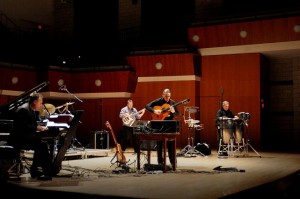 A new feature introduced in SONAR Platinum that is helping me save a lot of time is the Mix Recall. These have been very useful because I can easily manage two versions of a mix within the same project. For example, I perform a lot of solo gigs and I create my own backing tracks from my albums. I perform with a Bose L1 Model 2 speaker which is a mono setup. Sometimes a mix just does translate the way I would like it to in mono. Usually an arpeggiated guitar part or harmony does not pop as much as it did in stereo. So I will create a second version of the mix with a few key parts bumped up a bit for a better balanced mono backing track. Of course the lead parts are muted 😉
A new feature introduced in SONAR Platinum that is helping me save a lot of time is the Mix Recall. These have been very useful because I can easily manage two versions of a mix within the same project. For example, I perform a lot of solo gigs and I create my own backing tracks from my albums. I perform with a Bose L1 Model 2 speaker which is a mono setup. Sometimes a mix just does translate the way I would like it to in mono. Usually an arpeggiated guitar part or harmony does not pop as much as it did in stereo. So I will create a second version of the mix with a few key parts bumped up a bit for a better balanced mono backing track. Of course the lead parts are muted 😉
CAKEWALK: With a lot of different guitar parts on some of these tracks, what do you do to make sure everything stays separated and distinguished?
 E. HANSEN: Panning is key. One of my heroes is Al di Meola. His last 3 albums (not counting his Beatles project) have a lot of contrapuntal writing. He keeps the parts separated by panning parts far left, right and usually keeping the main melody center. I’ve employed this method on this project to make sure any part can be clearly heard if you focus your ear’s attention to them. Sometimes I double up an arpeggiated guitar part with steel string on one side and nylon string on the other to fill out the sound and leave the melody in the middle. The overall guitar sound becomes really big in stereo and also sums very well to mono. When initially arranging an idea, I tend to go overboard at first and then start pulling out parts until the important ones rightfully stand out. It’s a never ending learning process and it requires a lot of listening to mixes I admire a lot. One album that has blown me away sonically is Lee Ritenour’s Rhythm Sessions. That has to be one the most incredible recorded and mixed albums I’ve ever heard. The bass is deep and rich but not overwhelming. The guitars are pristine and perfectly balanced. The compositions are breathtaking and the arrangement of every piece is a study in itself. I often drop a mix from that album into mine to make quick comparisons. I’ve yet to match one but I keep trying!
E. HANSEN: Panning is key. One of my heroes is Al di Meola. His last 3 albums (not counting his Beatles project) have a lot of contrapuntal writing. He keeps the parts separated by panning parts far left, right and usually keeping the main melody center. I’ve employed this method on this project to make sure any part can be clearly heard if you focus your ear’s attention to them. Sometimes I double up an arpeggiated guitar part with steel string on one side and nylon string on the other to fill out the sound and leave the melody in the middle. The overall guitar sound becomes really big in stereo and also sums very well to mono. When initially arranging an idea, I tend to go overboard at first and then start pulling out parts until the important ones rightfully stand out. It’s a never ending learning process and it requires a lot of listening to mixes I admire a lot. One album that has blown me away sonically is Lee Ritenour’s Rhythm Sessions. That has to be one the most incredible recorded and mixed albums I’ve ever heard. The bass is deep and rich but not overwhelming. The guitars are pristine and perfectly balanced. The compositions are breathtaking and the arrangement of every piece is a study in itself. I often drop a mix from that album into mine to make quick comparisons. I’ve yet to match one but I keep trying!
CAKEWALK: How do you use the PRV in terms of workflow?
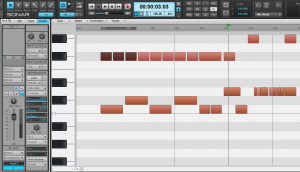 E. HANSEN: The new PRV is great for arranging and adjusting MIDI based percussion and drum parts. I can quickly get access to velocity levels or nudge a particular hit forward or backward to improve a feel. I’ve started relying less on pre-recorded hand percussion loops or MIDI grooves and programming my own patterns. One of the things that is crucial to making a MIDI based hand percussion part sound real is proper articulation dynamics. If you watch a video of a guitarist strumming chords with the sound muted it looks like they are strumming a steady eight note pattern. However, there are some strokes that are accented and others that are hardly even heard but fill in the space. Percussion patterns are exactly the same way—you have the basic hits of the groove, but all the quiet hits in between the accent parts is what really brings it to life. I create grooves using an Akai MPD26. More often than not the dynamics of the articulation is not ideal. I will go into the PRV and make quick adjustments to the pattern until the part sounds as close to a real player as I can get it. In this screen grab you can see the dynamics of a Djembe pattern:
E. HANSEN: The new PRV is great for arranging and adjusting MIDI based percussion and drum parts. I can quickly get access to velocity levels or nudge a particular hit forward or backward to improve a feel. I’ve started relying less on pre-recorded hand percussion loops or MIDI grooves and programming my own patterns. One of the things that is crucial to making a MIDI based hand percussion part sound real is proper articulation dynamics. If you watch a video of a guitarist strumming chords with the sound muted it looks like they are strumming a steady eight note pattern. However, there are some strokes that are accented and others that are hardly even heard but fill in the space. Percussion patterns are exactly the same way—you have the basic hits of the groove, but all the quiet hits in between the accent parts is what really brings it to life. I create grooves using an Akai MPD26. More often than not the dynamics of the articulation is not ideal. I will go into the PRV and make quick adjustments to the pattern until the part sounds as close to a real player as I can get it. In this screen grab you can see the dynamics of a Djembe pattern:
CAKEWALK: This is a major-label sounding record; what was the overall process for recording the album?
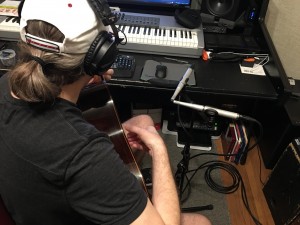 E. HANSEN: In the past I relied on drum and percussion loops to get the creative juices flowing. I would loop out a groove for 10 minutes and record several long takes of improvisations. If I was lucky there would be a few good chunks of material to create a composition from. A few years ago I had exhausted the best loops in my library so I started composing with only the guitar. I’ll jump into SONAR and start laying down riffs and chords progressions and then begin working out melodies. It took some time to get comfortable working this way, but it was very liberating because I was not bound to a particular groove, feel or mood. Ideas came faster and developed much more quickly, but were also sometimes a bit sporadic. Arranging sections is so easy in a DAW; I always record to a click track so it is very easy to cut and paste sections of a tune in development until it flows properly.
E. HANSEN: In the past I relied on drum and percussion loops to get the creative juices flowing. I would loop out a groove for 10 minutes and record several long takes of improvisations. If I was lucky there would be a few good chunks of material to create a composition from. A few years ago I had exhausted the best loops in my library so I started composing with only the guitar. I’ll jump into SONAR and start laying down riffs and chords progressions and then begin working out melodies. It took some time to get comfortable working this way, but it was very liberating because I was not bound to a particular groove, feel or mood. Ideas came faster and developed much more quickly, but were also sometimes a bit sporadic. Arranging sections is so easy in a DAW; I always record to a click track so it is very easy to cut and paste sections of a tune in development until it flows properly.
Another essential writing tool has been my iPhone. A lot of times my best ideas come when I start warming up at a gig. I can quickly record a riff and develop it later. I would say 70% of the current project was spawned from a riff I recorded to my phone at a gig.
Once a tune is in a finished demo form I will create a backing track and start playing it on gigs. It’s a good way to get a feel if a composition is connecting with an audience or not. Over a sample of 15-20 gigs I will know if something needs to be added or changed. It’s always interesting how different I will play something live verses in the studio. I tend to take a lot more chances live and sometimes there are happy mistakes. I’ll make a note of it and introduce the idea into the next revision. Most tunes go through 3 to 5 revisions where I may clean up parts to make them work together better either harmonically or rhythmically.
CAKEWALK: You had mentioned you are using Windows 10 and a 4k monitor; how does that work?
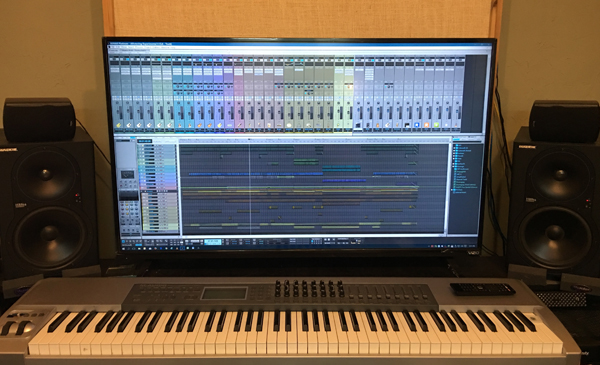 E. HANSEN: It works great. One of the coolest things about Windows 10 is how well the OS scales on various displays. I’m using a Vizio 50” 4K TV as my display and have Windows 10 set to scale at 150% which is the perfect size for running the OS and most apps. I run SONAR in two different ways. When I’m MIDI programming I set SONAR to scale to 150% with the OS. This is good for allowing plugin GUIs to display larger which is easier to see. For example, Superior Drummer has lots of small fonts and scaling at 125-150% lets me see them comfortably. Alternatively, when I’m recording or mixing I want to have a lot of channel strips in the Console View in tandem with a large clips pane in the Track View. So I will disable display scaling to get the maximum amount of data on my display. This is achieved by right clicking on the SONAR icon and selecting properties. From there I can disable display scaling under the compatibility options. It’s like having 4 22” 1080p displays in one.
E. HANSEN: It works great. One of the coolest things about Windows 10 is how well the OS scales on various displays. I’m using a Vizio 50” 4K TV as my display and have Windows 10 set to scale at 150% which is the perfect size for running the OS and most apps. I run SONAR in two different ways. When I’m MIDI programming I set SONAR to scale to 150% with the OS. This is good for allowing plugin GUIs to display larger which is easier to see. For example, Superior Drummer has lots of small fonts and scaling at 125-150% lets me see them comfortably. Alternatively, when I’m recording or mixing I want to have a lot of channel strips in the Console View in tandem with a large clips pane in the Track View. So I will disable display scaling to get the maximum amount of data on my display. This is achieved by right clicking on the SONAR icon and selecting properties. From there I can disable display scaling under the compatibility options. It’s like having 4 22” 1080p displays in one.
CAKEWALK: How will this record be mastered?
E. HANSEN: I will be doing it. Bob Katz at Digital Domain mastered some of my earlier albums. I sat in on all those sessions and soaked up everything I could. I’ve admire his philosophy preserving dynamics, space and clarity in his mastering techniques. As a result, I don’t make my mixes super loud. I prefer the audience to simply turn up their system and enjoy the dynamic range and clarity I strive for in my mixes.
 I begin the mixing process with the mastering plugins already on the master bus and mix into them. I use Izotope’s Ozone 5 Advanced Imager for adding stereo width and the EQ for making small adjustments to the mix after listening on various systems. Before the Ozone plugin, I have the Steven Slate Virtual Console, Virtual Bus Compressors and Virtual Tape Machines on my master bus. Lastly I use Steven Slate FG-X for limiting with K-System (K14) metering for adjusting the RMS of the mix. I typically add between 5 and 6 dB of limiting to my mixes.
I begin the mixing process with the mastering plugins already on the master bus and mix into them. I use Izotope’s Ozone 5 Advanced Imager for adding stereo width and the EQ for making small adjustments to the mix after listening on various systems. Before the Ozone plugin, I have the Steven Slate Virtual Console, Virtual Bus Compressors and Virtual Tape Machines on my master bus. Lastly I use Steven Slate FG-X for limiting with K-System (K14) metering for adjusting the RMS of the mix. I typically add between 5 and 6 dB of limiting to my mixes.
Eric Hansen’s new record will be coming out early this summer. For more information on Eric’s latest creations, live performances including his band Hansenhaus, please visit www.ericguitar.com.
Eric Hansen is a great example of the new-age music industry musician carving his own path. We are always proud and grateful to hear stories like this where our software is helping people achieve their musical goals .
To get started with your own music-creation story, we invite you to download and TRY SONAR FOR FREE, and then visit CakeTV for everything you need to know.
Thanks for reading

